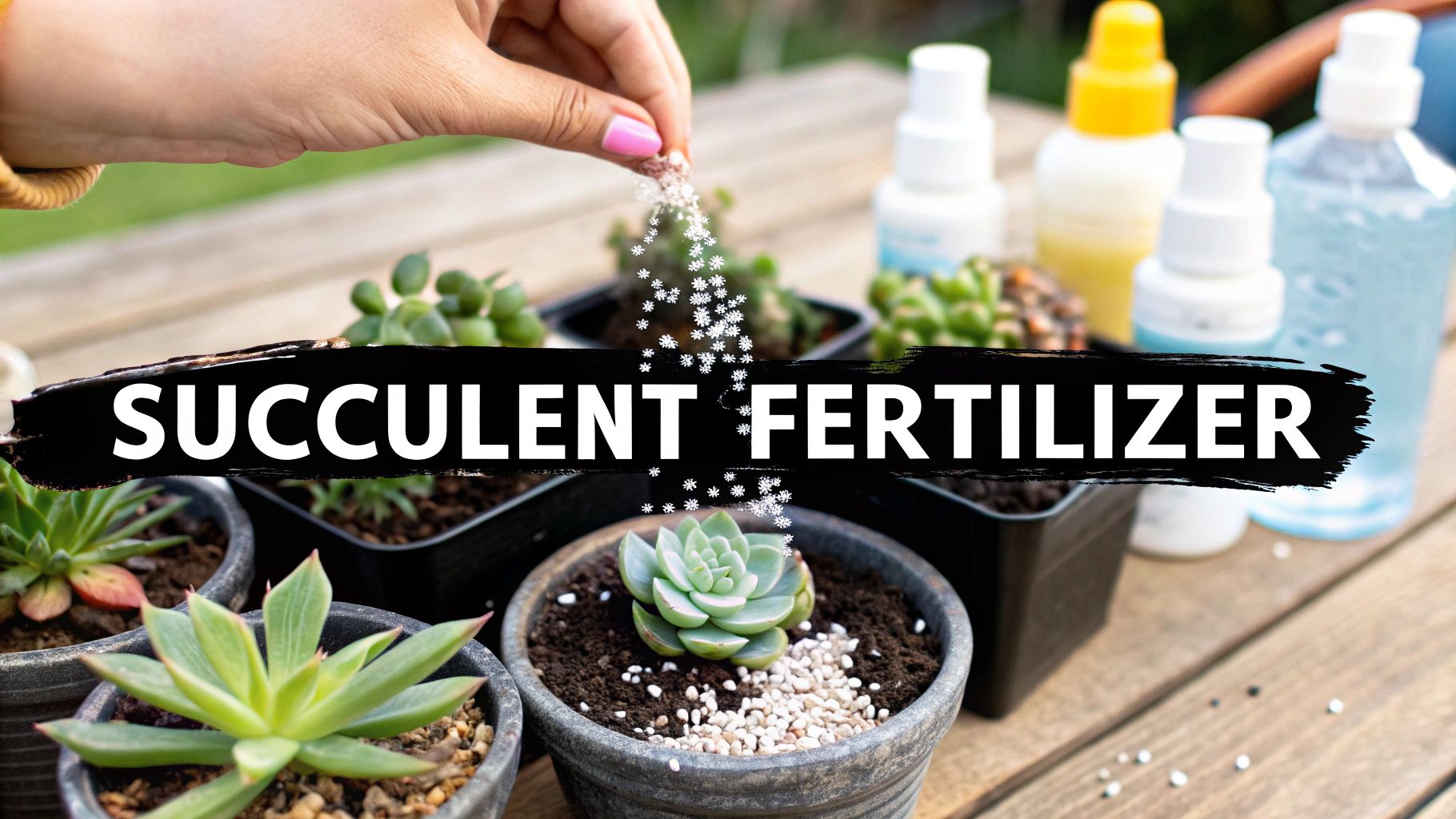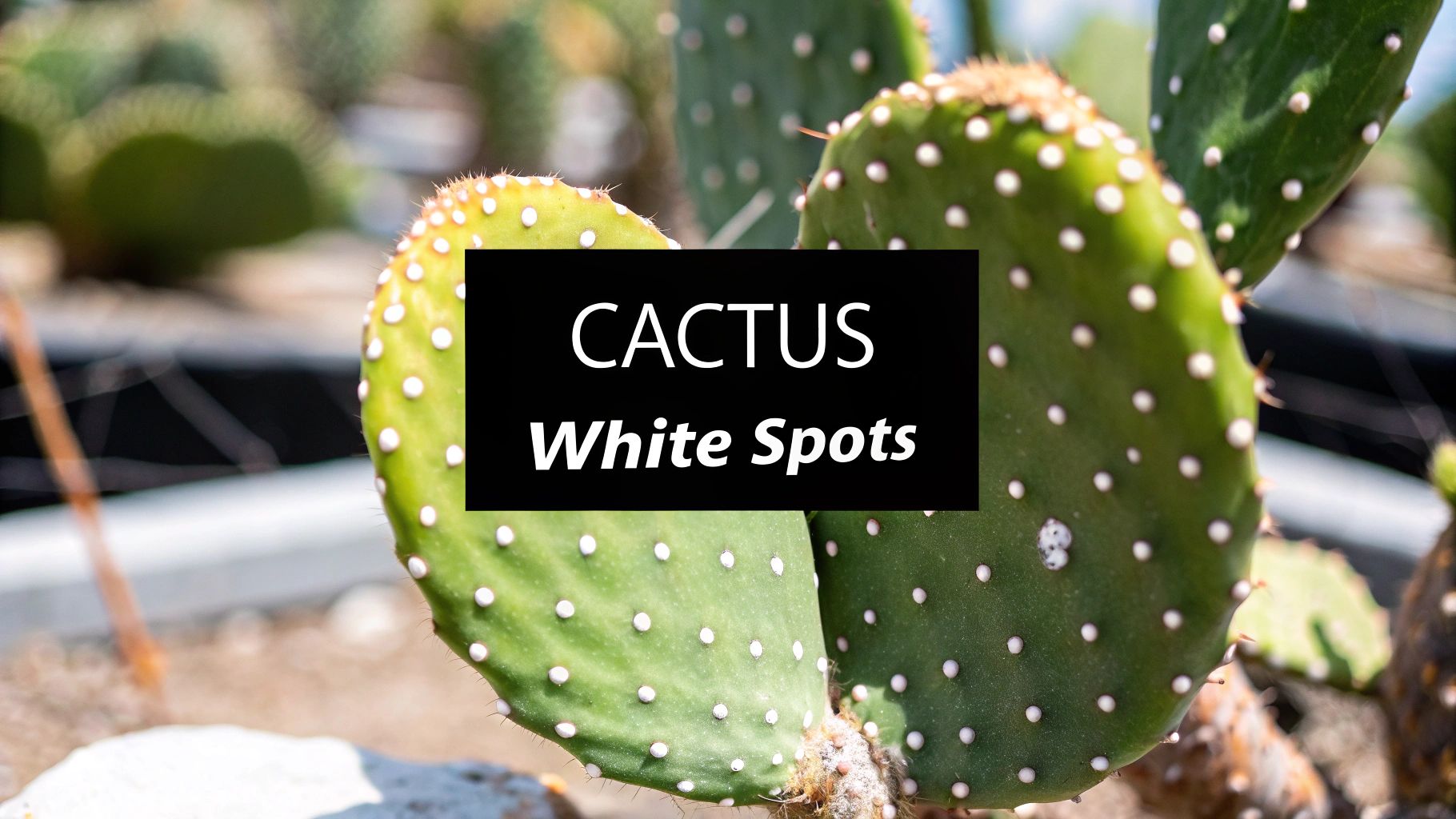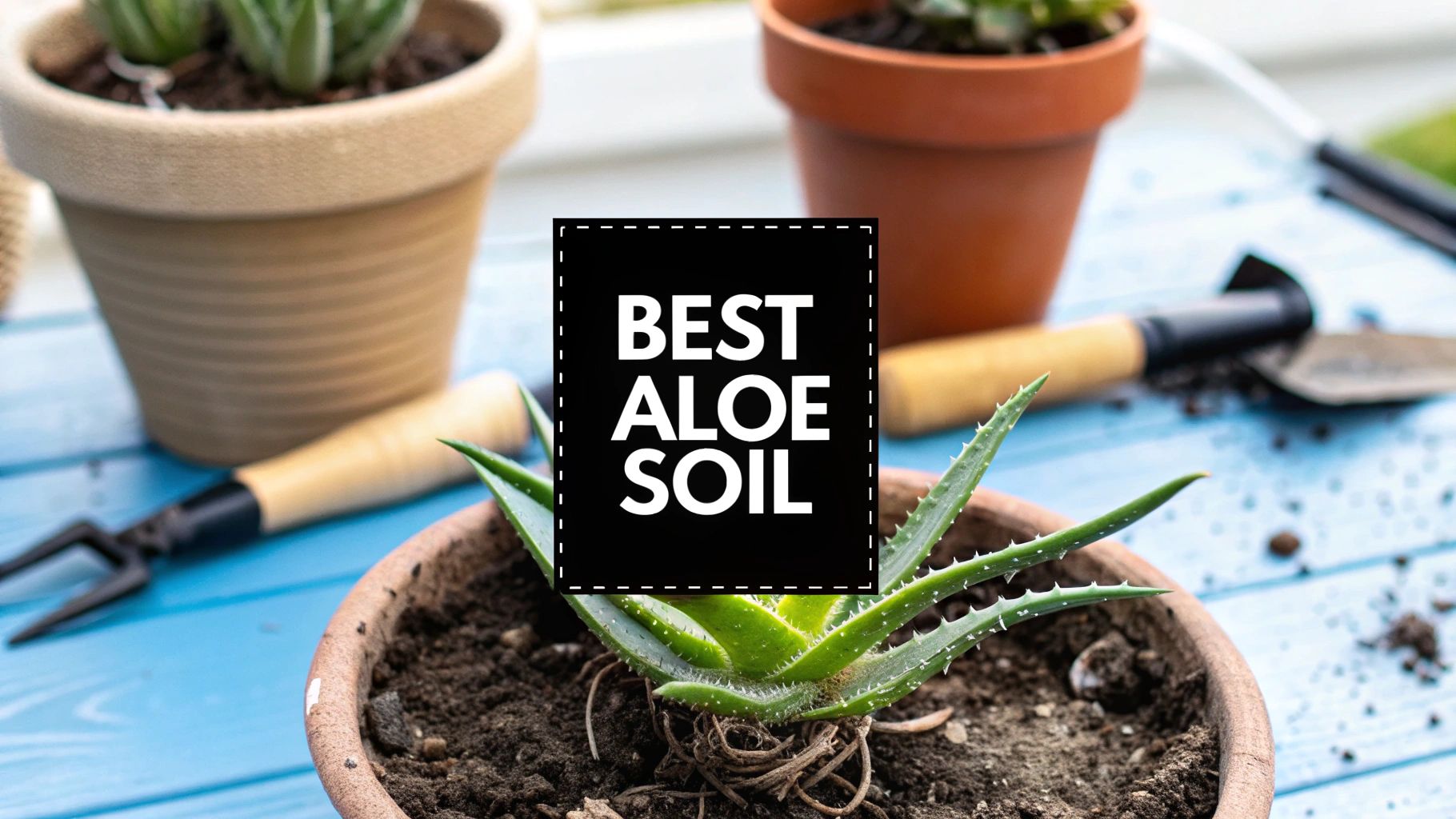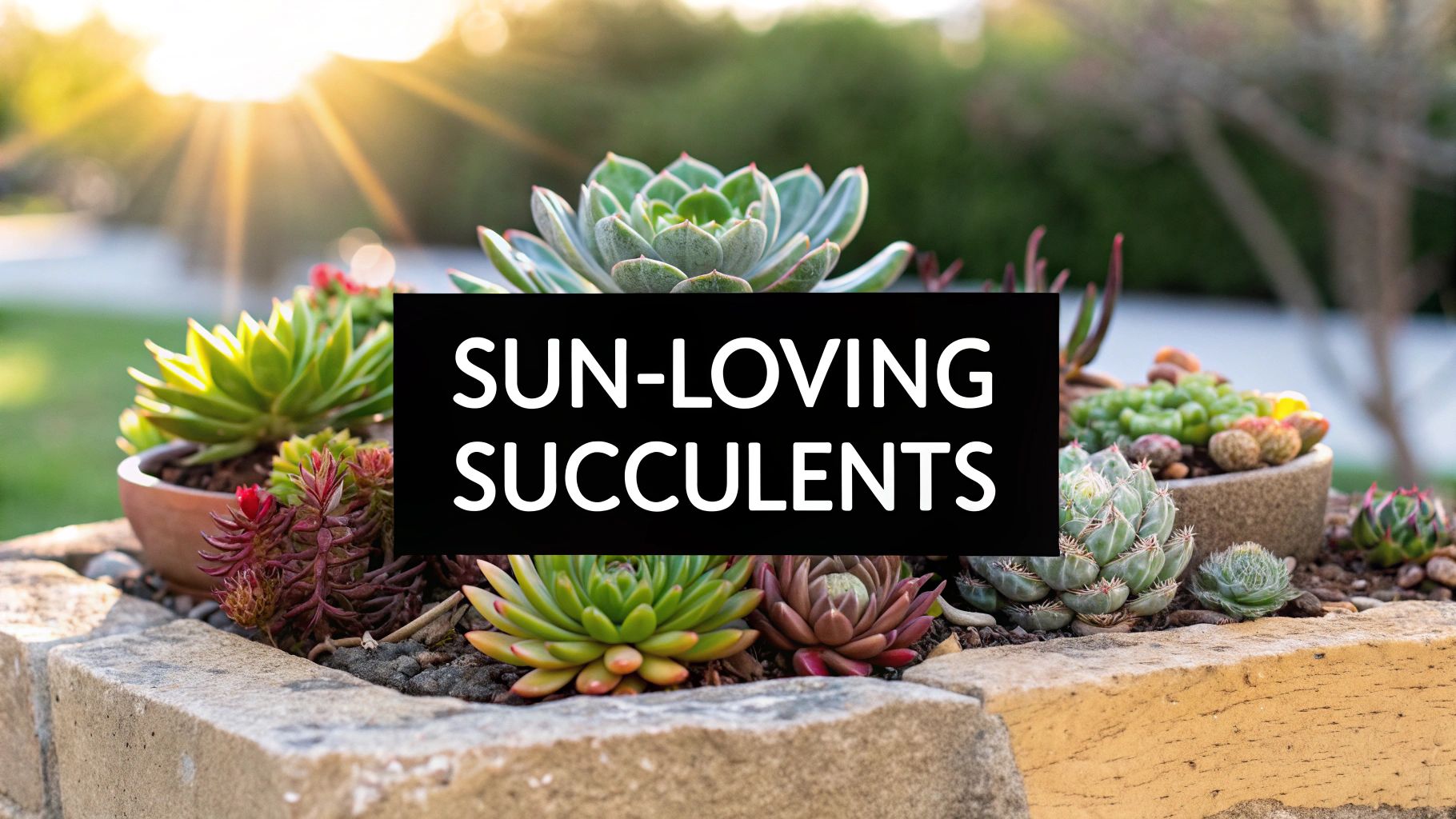So, what's the best fertilizer for succulents? I always recommend a low-nitrogen, balanced liquid formula. You'll want to dilute it to half or even quarter strength. Look for NPK ratios like 3-4-5 or 5-10-10—these are perfect for encouraging strong roots and keeping the growth compact, preventing that weak, stretched-out look we all want to avoid.
Why Your Succulents Need Feeding
It's a common myth that succulents thrive on neglect. Yes, they're incredibly tough, but they aren't 'no-maintenance' plants. Out in their native deserts, the soil gets a slow, steady supply of nutrients from nature. In a pot, however, your succulent is living in a closed system. Every time you water, you're washing away a tiny bit of the nutrients in the soil, and they don't get replaced.
Think of fertilizer as a multivitamin for your plant. It puts back the essential minerals that your potted succulent simply can't get otherwise, giving it the fuel it needs to live a healthy life. Proper feeding is really the secret to helping them reach their full potential.
Unlocking Vibrant and Healthy Growth
The right nutrients are about so much more than just keeping the plant alive; they're the key to a thriving plant. When you nail the feeding routine, you'll start to see some amazing changes:
- Vibrant Colors: Many succulents show off their most brilliant reds, purples, and oranges only when they have enough phosphorus and potassium.
- Stronger Roots: A well-fed root system is the foundation of a healthy plant. It anchors your succulent securely and gets much better at absorbing water and nutrients, making it far more resilient.
- Encouraged Blooms: For succulents like Echeverias and Crassulas, fertilizing during their growing season gives them the extra energy they need to produce those beautiful, delicate flowers.
This love for succulents isn't just a niche hobby anymore. The global market was recently valued at around $11.67 billion and is expected to keep growing. This boom is what drives the demand for better, more specialized care products for our plants.
Giving your succulent the best fertilizer is like providing a healthy diet. It builds a strong immune system, helps the plant resist pests and diseases, and ensures it has the energy for robust growth.
Ultimately, getting these basics right lays the groundwork for everything else. For a complete look at all aspects of care, check out our comprehensive succulent plant care guide. Once you understand what your plants are asking for, you can stop guessing and start choosing the perfect fertilizer to help them truly flourish.
Decoding NPK for Succulent Health
Walking into the fertilizer aisle can be a little intimidating. You’re hit with a wall of bags and bottles plastered with numbers and chemical jargon. But here’s the good news: for succulents, the most important info is right there on the front.
It’s called the NPK ratio—that simple set of three numbers is your cheat sheet for picking the right stuff.
Think of NPK as a plant’s primary diet plan. Each letter stands for one of the three main macronutrients every plant needs, but succulents have their own unique "dietary" requirements.
- N is for Nitrogen: I call this the 'green growth' nutrient. Nitrogen is all about fueling leafy, vegetative growth. It’s what makes a fern lush or a lawn vibrant green.
- P is for Phosphorus: This is the 'roots and shoots' nutrient. Phosphorus is the powerhouse for building a strong foundation. It drives healthy root development and gives succulents the energy they need to flower.
- K is for Potassium: Think of this as the 'health and resilience' nutrient. Potassium is like a plant's multivitamin, helping it regulate water, fend off diseases, and handle stress from heat or cold.
Once you get that "Green-Roots-Resilience" idea, you’re halfway there. The next step is understanding why the balance between them is so critical, especially for succulents.
Why Low Nitrogen Is Non-Negotiable
Your leafy pothos or monstera might guzzle high-nitrogen food to push out new leaves, but succulents play by a completely different set of rules. For them, a high-nitrogen fertilizer is actually a recipe for disaster.
Too much nitrogen forces succulents into a sudden, weak growth spurt. This unnatural stretching, called etiolation, creates soft, floppy stems and pale leaves, even if the plant is getting plenty of light. This leggy growth isn't just unattractive; it’s a magnet for pests like mealybugs and is incredibly prone to rot.
With succulents, the goal is always compact, sturdy, and resilient growth—the kind they have in their tough native habitats. A low-nitrogen formula is key because it encourages the plant to build a strong structure instead of flimsy, fast growth.
This infographic really helps visualize how the right nutrient balance supports a healthy, happy succulent from the inside out.
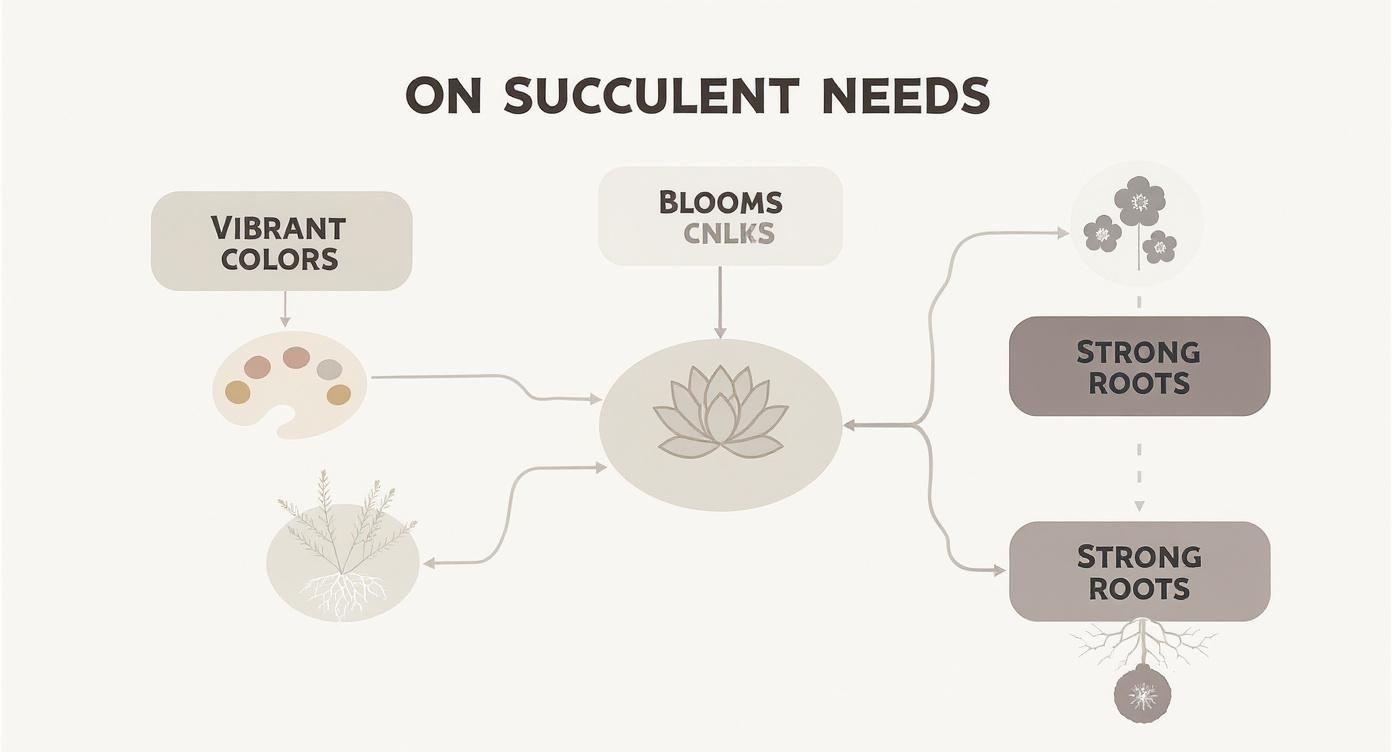
As you can see, what you feed your plant directly impacts its root strength, ability to bloom, and even the vibrancy of its colors.
To get a clearer picture of what each nutrient does—and what happens when things get out of balance—take a look at this table.
Understanding Succulent NPK Needs
| Nutrient (Symbol) | Primary Function ('The Analogy') | Effect of Too Much | Effect of Too Little |
|---|---|---|---|
| Nitrogen (N) | The 'Green Growth' Fuel. Encourages leaf and stem development. | Soft, weak, stretched growth (etiolation). Susceptible to pests & rot. | Stunted growth, yellowing of older leaves, slow to grow. |
| Phosphorus (P) | The 'Roots & Shoots' Powerhouse. Drives root formation, flowering, and energy transfer. | Can block the uptake of other micronutrients. Rarely an issue. | Weak root system, poor flowering, dull or purplish leaf color. |
| Potassium (K) | The 'Health & Resilience' Guard. Regulates water, boosts immunity, and improves stress tolerance. | Can interfere with magnesium uptake. | Yellowing along leaf edges, weak stems, poor disease resistance. |
Ultimately, it all comes down to balance. You want just enough nitrogen to keep the plant chugging along, but the real focus should be on phosphorus and potassium to build a strong, resilient succulent.
Finding the Ideal Succulent NPK Ratio
So, you know to steer clear of high nitrogen, but what numbers should you be looking for? The best fertilizers for succulents will have a balanced or low-nitrogen ratio. In simple terms, the first number (N) should be equal to or, even better, lower than the other two (P and K).
The key takeaway is simple: For succulents, the first number in the NPK ratio should never be the highest. Prioritize phosphorus and potassium to support the plant’s foundational health.
Look for formulas with NPK ratios like 3-4-5 or 5-10-10. These blends provide just enough nitrogen for healthy function without sending your plant into a weak growth frenzy. Meanwhile, the higher phosphorus and potassium levels get to work building a robust root system and boosting overall plant vigor.
More growers are realizing that one-size-fits-all fertilizers just don't cut it. In fact, research shows that succulents do best with these low-N formulas applied just 2–4 times per year during their active growing season. This shift has led to more specialized succulent foods on the market, a trend highlighted in recent analyses by Fortune Business Insights. With this know-how, you can finally walk down that fertilizer aisle with confidence.
Choosing Between Liquid and Granular Fertilizer
When you head to the garden center or browse online, you'll see two main players in the succulent fertilizer game: liquid and granular. There isn't a single right answer here; the best one really depends on your plants, your schedule, and how hands-on you like to be. Let's break down how each one works so you can figure out what fits your style.
Think of liquid fertilizer as a quick shot of nutrients. It's instantly available, giving your succulents a fast and direct boost right at the roots. This gives you incredible control over when and how much you feed your plants, which is perfect if you enjoy fine-tuning your care routine with the seasons.
The golden rule with liquid feed is to always, always dilute it. I usually recommend mixing it to half or even a quarter of the strength listed on the bottle. Using it full-strength is way too much for a succulent's sensitive root system—it’s the fastest way to cause fertilizer burn.
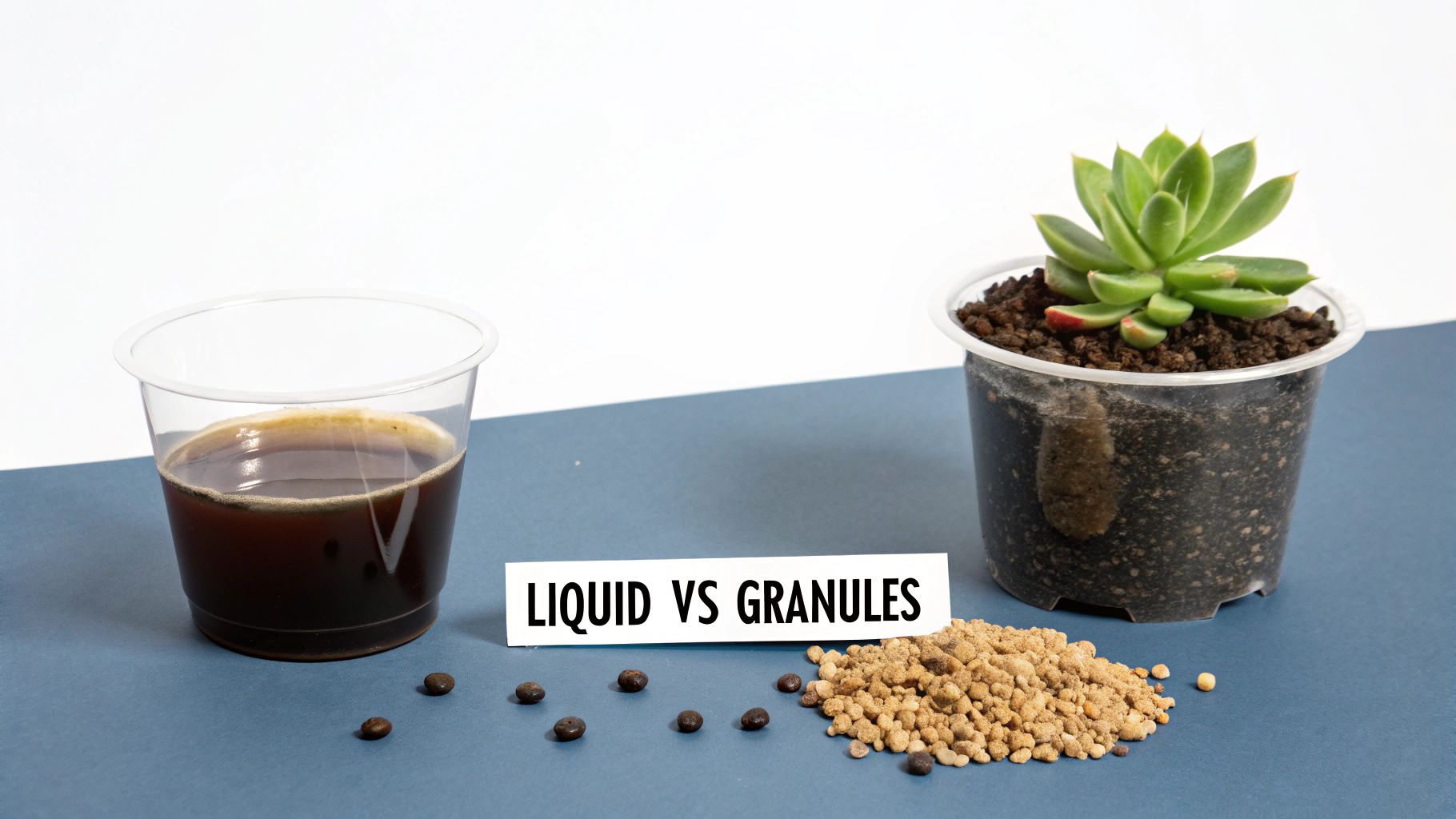
The Set-It-and-Forget-It Method
On the other side of the aisle, you have granular fertilizer. I like to think of this as a slow-cooked meal for your plants. These are the "slow-release" or "controlled-release" options. You just mix the little pellets into the soil when you repot, or sprinkle them over the top, and they do the rest, breaking down slowly over months to provide a gentle, steady stream of food.
This approach is a lifesaver if you're busy or just prefer a low-maintenance routine. It's a much more natural way for succulents to get nutrients, mimicking the slow and steady process they'd experience in the wild. This slow delivery also makes it incredibly hard to overdo it, virtually eliminating the risk of fertilizer burn and making it a great, safe choice for beginners.
It all boils down to speed and control. Liquid offers a fast, precise nutrient hit that you manage, while granular gives you gentle, long-term nutrition with almost no effort.
These slow-release formulas are getting seriously sophisticated. The global specialty fertilizer market, which was recently valued at $27.02 billion, is investing heavily in these types of products. Many now use a polymer coating that releases nutrients in response to soil temperature and moisture—a perfect match for a succulent's needs. You can get a deeper look at this trend in various market research insights.
Making the Right Choice for You
So, which one should you grab? Let’s put it this way:
- Go with Liquid if: You have a small collection, you find the ritual of plant care relaxing, and you want to customize feeding for specific plants throughout the year.
- Go with Granular if: You have a ton of plants, a packed schedule, or you’re a little nervous about accidentally over-fertilizing. It’s the foolproof option for consistent, safe feeding.
At the end of the day, both can give you fantastic results when used correctly. One gives you immediate feedback and total control, while the other offers long-term peace of mind.
Organic Versus Synthetic Succulent Food
When you start looking for succulent fertilizer, you'll quickly realize there are two main camps: organic and synthetic. The fundamental difference between them is pretty simple, but it changes everything about how they work.
Synthetic fertilizers are designed to feed the plant directly. Organic options, on the other hand, focus on feeding the soil, which in turn feeds the plant.
Think of synthetic fertilizers as a quick energy shot for your succulent. They deliver a precise, lab-formulated dose of nutrients—like nitrogen and phosphorus—in a way the plant can absorb almost instantly. This is great when you want fast, predictable results, like encouraging a reluctant bloomer or helping a plant bounce back.
Organic fertilizers are more like a slow-simmered, nourishing stew for your soil. Things like worm castings, compost tea, or bone meal aren't just about adding nutrients; they're about building a healthy, living soil ecosystem. They feed the good microbes, improve the soil's structure, and create a resilient environment that helps your succulents thrive naturally over the long haul.
The Trade-Offs in Your Approach
So, which one is right for you? It really boils down to your personal gardening philosophy and what you're trying to achieve.
Synthetics give you speed and precision, but they also carry a much higher risk of fertilizer burn if you get the dilution wrong. They're a bit like a powerful tool that requires careful handling. And since they only feed the plant, they do nothing to improve the soil itself over time.
Organic methods are far more forgiving. Because the nutrients are released slowly as microorganisms in the soil do their work, the chance of burning your succulent's sensitive roots is practically zero. It’s a gentle, steady approach that builds richer, more fertile soil for years to come.
There is no single "best" choice, only the best choice for you. It's a balance between the immediate, controlled results of synthetics and the holistic, soil-building benefits of an organic approach.
For many of us, the slow-and-steady nature of organic feeding just feels right for these slow-growing plants.
Organic vs. Synthetic Fertilizer Comparison for Succulents
To really see the differences side-by-side, it helps to look at a direct comparison. Here's a table that breaks down how each type performs, which can help you decide which path is a better fit for you and your plants.
| Feature | Organic Fertilizer (e.g., Worm Castings) | Synthetic Fertilizer (e.g., Liquid 3-4-5) |
|---|---|---|
| Speed of Action | Slow-release, providing nutrients gradually over weeks or months. | Fast-acting, with nutrients immediately available to the plant. |
| Nutrient Source | Derived from natural materials like compost, manure, and kelp. | Manufactured from chemical compounds for precise NPK ratios. |
| Risk of Burn | Very low; the slow-release nature makes it difficult to overfeed. | Higher; requires careful dilution to avoid damaging sensitive roots. |
| Soil Health | Improves soil structure, aeration, and microbial life over time. | Does not contribute to long-term soil health or structure. |
In the end, whether you lean towards the immediate boost of a synthetic formula or the soil-first philosophy of organics, understanding this core difference is crucial. Making the right choice will give your succulents exactly what they need for that strong, compact, and vibrant growth we all love.
Your Succulent Fertilizing Schedule and Method
Picking the right fertilizer is only half the puzzle. Knowing exactly when and how to use it is what will make your succulents truly thrive. When it comes to feeding these plants, timing is everything.
The golden rule is simple: only fertilize during the active growing season. For most succulents, this means spring through summer.
Think of it this way: your succulent is like a hibernating bear in winter. Its metabolism slows right down, and it's essentially sleeping. Trying to feed it then is like shoving food at a snoozing bear—the system can't process it. Instead, the unused fertilizer salts just sit in the soil, where they can end up burning the roots.
Creating the Perfect Feeding Routine
With succulents, the "less is more" approach is always your best bet. These aren't greedy plants. In fact, over-fertilizing is a much bigger and more common problem than not feeding them enough.
Here’s a straightforward schedule that works wonders:
- Start in Spring: Once your plants start waking up from their winter nap and you spot fresh growth (usually around March or April), it's go-time.
- Feed Sparingly: Use a diluted fertilizer just once every 4 to 8 weeks all through the spring and summer.
- Stop in Fall: As the days get shorter and cooler, around September, it's time to stop. This lets the plant prepare for its winter rest.
Following this moderate routine gives your succulents all the fuel they need for healthy, compact growth without overwhelming their delicate systems.
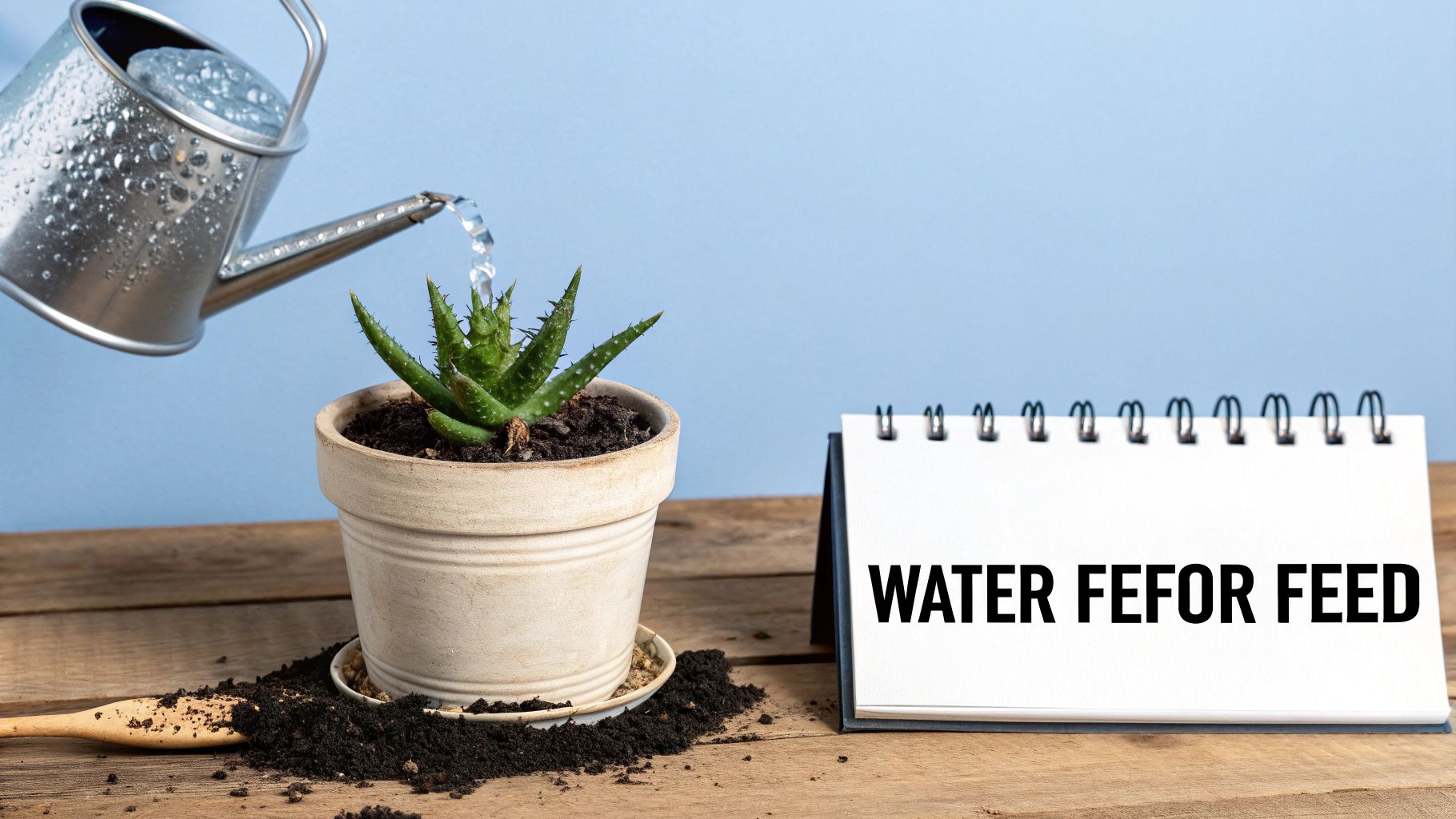
The Correct Way to Apply Fertilizer
How you feed your succulents is just as critical as when. Their roots are notoriously sensitive, and pouring concentrated fertilizer on them can cause a nasty condition called fertilizer burn.
The most important rule of application: Always, always water your succulent with plain water before you add fertilizer. This simple step moistens the soil and acts as a buffer, protecting the roots from the harsh, concentrated salts in the fertilizer.
Think about pouring a strong cleaning liquid onto a dry sponge—it’s intense and concentrated. But if that sponge is already damp, the liquid dilutes and spreads out gently. Watering first does the exact same thing for your plant's soil.
So, after your plant has had a good drink of plain water, you can go ahead and apply your diluted liquid fertilizer. This step is non-negotiable for keeping your plants healthy. Of course, none of this works without the right foundation—a fast-draining potting mix is key. You can learn all about it in our guide to the perfect cactus and succulent soil.
Reading the Signs From Your Plant
Believe it or not, your succulents will tell you if you're getting their diet wrong. If you learn to read the signs, you can fix the problem before any real damage is done.
Signs of Over-Fertilization:
- A crusty, white salt buildup on the surface of the soil or the rim of the pot.
- Sudden, weak, and stretched-out growth (often called "leggy" growth).
- Leaf tips or edges that turn brown and crispy.
- Lower leaves dropping off unexpectedly.
Signs of Under-Fertilization (This is much less common):
- Zero new growth during the spring and summer.
- Leaves look pale, yellow, or just generally washed-out.
- The plant just seems weak and isn't thriving, even with good light and water.
By sticking to a conservative schedule, always watering first, and keeping an eye on your plant, you can confidently give it the perfect amount of food. This simple method is the secret to strong, vibrant, and beautifully compact succulents for years to come.
Common Questions About Fertilizing Succulents
Even with the best plan, you're bound to have questions when you start a new care routine. When it comes to feeding succulents, a few key concerns pop up over and over. Let's walk through the most common ones so you can feel totally confident.
Can I Use a Regular Houseplant Fertilizer?
I get this question all the time. The short answer? It's a gamble. Standard houseplant foods are formulated for leafy, tropical plants, meaning they're loaded with nitrogen to push out tons of green growth. For a succulent, that’s like giving a toddler a double espresso—it forces weak, stretched-out growth that’s a magnet for pests and rot.
If you're in a pinch and it’s your only option, you absolutely have to dilute it to at least one-quarter strength. But honestly, reaching for a fertilizer made specifically for cacti and succulents is always the smarter, safer bet. It’ll encourage the strong, compact structure these plants are meant to have.
What Are the Signs of Over Fertilizing?
Oh yes, you can definitely have too much of a good thing. Over-fertilizing is probably one of the most common ways people accidentally harm their succulents. The good news is, your plant will give you some clear warning signs if it's getting overloaded with nutrients.
Keep an eye out for:
- A white, crusty salt buildup on the soil surface or around the pot's rim.
- Lower leaves that suddenly drop off, even though they look healthy.
- Brown or crispy leaf tips that look burned.
- Growth that seems unnaturally fast, weak, or "leggy," even when the plant is getting plenty of light.
If you see these signs, it's time to flush the soil. This just means watering the plant thoroughly with plain water a few times in a row, letting it drain completely each time. This washes away all those excess mineral salts. Afterward, take a break from fertilizing for a few months to give the plant time to recover. This process relies on good watering habits, which you can brush up on in our guide on how to water succulent plants.
Should I Fertilize a Newly Repotted Succulent?
Nope, definitely hold off for a bit. Repotting is a big deal for a plant! Its fine little roots have likely been disturbed and need time to heal and get settled in their new soil. Hitting them with fertilizer right away is a surefire way to burn those sensitive, recovering roots.
A good rule of thumb is to wait at least 4 to 6 weeks after repotting before you even think about fertilizing again. Most fresh cactus and succulent soils have enough of a nutrient charge to support the plant while it gets re-established.
What Are the Best Organic Fertilizer Options?
For growers who lean towards a more natural approach, there are some fantastic organic options that are perfectly gentle for succulents. These work differently, feeding the soil's ecosystem, which in turn nourishes the plant slowly and safely.
My favorite organic choices are:
- Worm Castings: This stuff is like black gold for plants. You can mix it right into your potting blend or sprinkle it on top as a slow-release, balanced meal.
- Compost Tea: A well-brewed and diluted compost tea introduces a ton of beneficial microbes to the soil, improving its overall health.
- Liquid Kelp or Fish Emulsion: These are also great, but you have to be careful. They need to be heavily diluted to bring the nitrogen way down, and you should only use them sparingly during the peak growing season.
The best part about these organic methods is that they're incredibly forgiving. It's almost impossible to burn your plants, which gives you great results with a lot less worry.
Ready to help your succulents thrive? Explore the stunning collection of healthy, well-cared-for cacti and succulents at The Cactus Outlet. Find your next favorite plant today at https://www.cactusoutlet.com.

